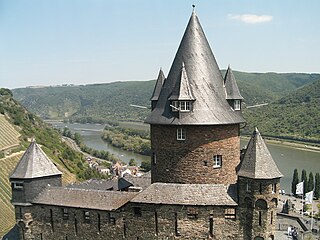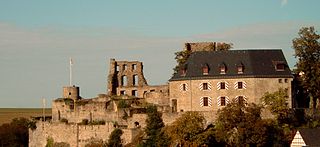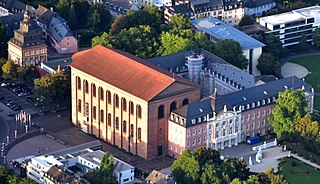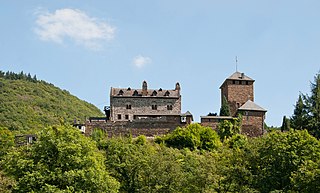
The Moselle is a river that rises in the Vosges mountains and flows through north-eastern France and Luxembourg to western Germany. It is a left bank tributary of the Rhine, which it joins at Koblenz. A small part of Belgium is in its basin as it includes the Sauer and the Our.
Mayen-Koblenz is a district (Kreis) in the north of Rhineland-Palatinate, Germany. Neighboring districts are Ahrweiler, Neuwied, Westerwaldkreis, district-free Koblenz, Rhein-Lahn, Rhein-Hunsrück, Cochem-Zell, and Vulkaneifel.

Stahleck Castle is a 12th-century fortified castle in the Upper Middle Rhine Valley at Bacharach in Rhineland-Palatinate, Germany. It stands on a crag approximately 160 metres (520 ft) above sea level on the left bank of the river at the mouth of the Steeg valley, approximately 50 kilometres (31 mi) south of Koblenz, and offers a commanding view of the Lorelei valley. Its name means "impregnable castle on a crag", from the Middle High German words stahel (steel) and ecke. It has a water-filled partial moat, a rarity in Germany. Built on the orders of the Archbishop of Cologne, it was destroyed in the late 17th century but rebuilt in the 20th and is now a hostel.

Schloss Veldenz in the Hunsrück upland, on a steep vale draining into the Mosel is a castle ruin about 1.5 kilometres (0.9 mi) southeast of the village of Veldenz in the German state of Rhineland-Palatinate.

Kastellaun Castle is a ruined medieval castle in Kastellaun in the Rhein-Hunsrück district in Rhineland-Palatinate, Germany.

Lissingen Castle is a well-preserved former moated castle dating to the 13th century. It is located on the River Kyll in Gerolstein in the administrative district of Vulkaneifel in Rhineland-Palatinate, Germany. From the outside it appears to be a single unit, but it is a double castle; an estate division in 1559 created the so-called lower castle and upper castle, which continue to have separate owners. Together with Bürresheim and Eltz, it has the distinction among castles in the Eifel of never having been destroyed.

Windeck Castle, also Old Windeck Castle, is a ruined Black Forest spur castle which stands on a 378-metre-high spur in the Bühl district of Kappelwindeck, in the county of Rastatt in the German state of Baden-Württemberg.

The Rauschenburg, also called Rauschenburg Castle, is the medieval ruin of a hill castle, located at around 250 metres above sea level, above the Ehrbach stream in the parish of Mermuth in the county of Rhein-Hunsrück-Kreis in the German state of Rhineland-Palatinate.

The ruins of Trutzeltz Castle, also known as Balduineltz, Baldeneltz or Neueltz, are the remains of a hill castle in the valley of the Elz in the parish of Wierschem near the town of Münstermaifeld. It was built as a counter-castle during the medieval Eltz Feud in the Moselle region.

Schloss Schöneck is a castle which stands on a rock outcrop in the Ehrbach Gorge in the borough of Boppard in the Hunsrück mountains of Germany.

The Ehrenburg is the ruin of a spur castle at 230 m above sea level (NN) in the vicinity of Brodenbach in Germany. The castle had a very eventful history. It was built on a rocky spur in the valley of the Ehrbach, a right bank valley of the Moselle. Once the fortified heart of a small imperial barony with estates between the Lower Moselle and Middle Rhine, it is today a cultural monument that hosts numerous events.

The Old Castle was a former Elector-owned, substantial water castle in the German city of Koblenz, incepted in the 13th century. It is today reduced to the later Burghaus ; which houses the city archives. It sits on tall foundations and has a tall, black slate roof with further floors in the attic and two small cupolas. The lowland castle abutted the remaining building in the old town quarter. The castle house stands tall, next to the Moselle's right-bank towpath downstream of the strategic Baldwin Bridge built in 1342. The bridge, much-repaired, remains intact.

The ruins of Ramstein Castle stand on a 182-metre-high, Bunter sandstone rock on the edge of the Meulenwald forest in the lower, steep-sided Kyll valley near Kordel in the German state of Rhineland-Palatinate. It stands 9 kilometres (5.6 mi) north of Trier and the same east of Luxembourg.

Wernerseck Castle, also called the Kelterhausburg, is a late medieval hill castle in the municipality of Ochtendung in the county of Mayen-Koblenz in the German state of Rhineland-Palatinate. It owes its name to its founder and lord of the castle, the Archbishop of Trier, Werner of Falkenstein (1388–1418). "Wernerseck" means "Werner's corner".

The ruins of Nideggen Castle are a symbol of the town of Nideggen in Germany and are owned by the county of Düren. The rectangular hill castle was the seat of the powerful counts and dukes of Jülich and had a reputation in the Middle Ages of being impregnable.

The Niederburg at Kobern, also called the Niedernburg, Unterburg or Neue Burg, is a hill castle above the municipality of Kobern-Gondorf in the county of Mayen-Koblenz in the German state of Rhineland-Palatinate.

The Oberburg at Kobern, also called the Oberburg or Altenburg, is a hill castle above the municipality of Kobern-Gondorf in the county of Mayen-Koblenz in the German state of Rhineland-Palatinate.

The Electoral Palace in Trier, Germany, was the residence of the Archbishops and Electors of Trier from the 16th century until the late 18th century. It now houses various offices of the federal government and often hosts classical music concerts.

Wildburg Castle is a restored castle complex in the municipality of Treis-Karden on the Moselle in the district of Cochem-Zell in the state of Rhineland-Palatine in Germany. It is located 30 kilometres south-west of the city of Koblenz.

Treis Castle, also called Treisburg, is a castle ruin in the municipality of Treis-Karden on the Moselle in the district of Cochem-Zell in the state of Rhineland-Palatine in Germany. It is located 30 kilometres south-west of the city of Koblenz.























